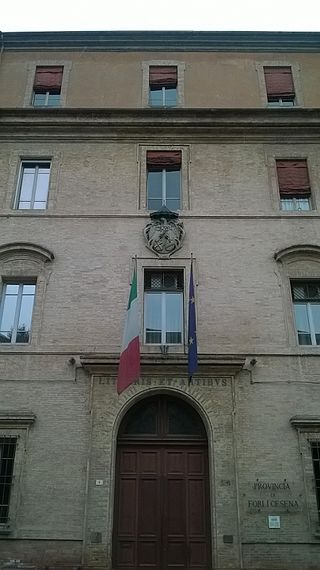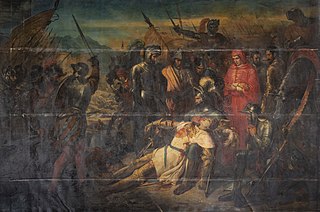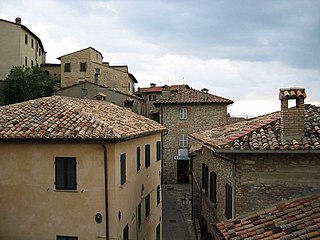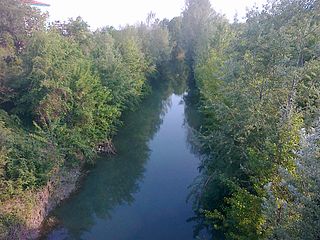
Adria is a town and comune in the province of Rovigo in the Veneto region of northern Italy, situated between the mouths of the rivers Adige and Po. The remains of the Etruscan city of Atria or Hatria are to be found below the modern city, three to four metres below the current level. Adria and Spina were the Etruscan ports and depots for Felsina. Adria may have given its name during an early period to the Adriatic Sea, to which it was connected by channels.

The Rubicon is a shallow river in northeastern Italy, just south of Cesena and north of Rimini. It was known as Fiumicino until 1933, when it was identified with the ancient river Rubicon, famously crossed by Julius Caesar in 49 BC.

Narni is an ancient hilltown and comune (municipality) of Umbria, in central Italy, with 19,252 inhabitants (2017). At an altitude of 240 metres (790 ft), it overhangs a narrow gorge of the River Nera in the province of Terni. It is very close to the geographical centre of Italy. There is a stone on the exact spot with a sign in multiple languages.

The Province of Forlì-Cesena is a province in the Emilia-Romagna region of Italy. Its capitals are the cities of Forlì and Cesena. The province has a population of 394,273 as of 2016 over an area of 2,378.4 square kilometres (918.3 sq mi). It contains 30 comuni and the provincial president is Davide Drei. Although located close to the independent Republic of San Marino, Forlì-Cesena does not share a land border with the sovereign state.

The province of Cremona is a province in the Lombardy region of Italy. Its capital city is Cremona.

SMS Viribus Unitis was an Austro-Hungarian dreadnought battleship, the first of the Tegetthoff class. "Viribus Unitis", meaning "With United Forces", was the personal motto of Emperor Franz Joseph I.

The Battle of Ravenna, fought on 11 April 1512, was a major battle of the War of the League of Cambrai. It pitted forces of the Holy League against France and their Ferrarese allies. Although the French and Ferrarese eliminated the Papal–Spanish forces as a serious threat, their triumph was overshadowed by the loss of their young general Gaston of Foix. The victory therefore did not help them secure northern Italy. The French withdrew entirely from Italy in the summer of 1512, as Swiss mercenaries hired by Pope Julius II and Imperial troops under Emperor Maximilian I arrived in Lombardy. The Sforza were restored to power in Milan.

Ronco Canavese is a comune (municipality) in the Metropolitan City of Turin in the Italian region Piedmont, located about 50 kilometres (31 mi) north of Turin.

Montone is a comune (municipality) in the Province of Perugia in the Italian region Umbria, located about 35 km north of Perugia. It is one of I Borghi più belli d'Italia.

The Senio is a 92-kilometre (57 mi) river of Romagna in Italy, the final right-sided tributary of the river Reno. The source of the river is in the province of Florence in the Appennino Tosco-Emiliano mountains. The river flows northeast into the province of Ravenna and flows near Casola Valsenio, Riolo Terme, Castel Bolognese, Cotignola, Lugo, Bagnacavallo, Fusignano and Alfonsine before entering the Reno. The river has a tributary called the Sintria that flows into it east of Riolo Terme. The river is along the road to Imola.

The Montone is a river in the historical region of Romagna, which is in the present-day region of Emilia-Romagna in northern Italy. It is the northernmost river on the east-facing slopes of the Apennines to flow directly into the Adriatic Sea rather than entering the Po. Its Latin name was Utis or Vitis.

The Santerno is a river in Romagna in northern Italy. It is a major tributary of the river Reno. In Roman times, it was known as the Vatrenus, although, in the Tabula Peutingeriana, it was already identified as the Santernus.
Emilia is a historical region of northern Italy, which approximately corresponds to the western and the north-eastern portions of the modern region of Emilia-Romagna, with the area of Romagna forming the remainder of the modern region.

The Bidente-Ronco is a river in the Emilia-Romagna region of Italy. The first portion of the river is called the Bidente. Once the river passes under the Ponte dei Veneziani in Meldola, the river is called the Ronco. The source of the river is near the border between the province of Forlì-Cesena, the province of Arezzo, and the province of Florence in the Foreste Casentinesi, Monte Falterona, Campigna National Park. The river flows northeast through the mountains in the province of Forlì-Cesena and flows near Santa Sofia, Galeata, Civitella di Romagna and Meldola. Beyond Meldola, the river flows north near Bertinoro, Forlimpopoli, and Forlì before crossing the border into the province of Ravenna. The river flows northeast until it joins the Montone south of Ravenna, and the resulting river is known as the Uniti. The Battle of Ronco took place here.
Andrea Malatesta was an Italian condottiero, a member of the Malatesta family of Romagna. He is also known as Malatesta da Cesena, a city he had inherited in 1385 from his father, Galeotto, together with Cervia and Bertinoro. In 1388 he was also recognized lord of Fossombrone.

The Rabbi is a river in the Tuscany and Emilia-Romagna regions of Italy. The source of the river is in the Foreste Casentinesi, Monte Falterona, Campigna National Park in the Appennino Tosco-Emiliano mountains in the province of Florence. The river crosses the border into the province of Forlì-Cesena and flows northeast near Premilcuore and Predappio before joining the Montone near Forlì.

The Lamone is a river in the Tuscany and Emilia-Romagna regions of Italy. The source of the river is in the Appennino Tosco-Emiliano mountains in the province of Florence. The river flows northeast near Marradi before crossing the border into the province of Ravenna. It continues flowing northeast near Brisighella, Faenza, Russi and Bagnacavallo before curving eastward north of Ravenna and entering the Adriatic Sea near Marina Romea and Marina di Ravenna.
The War of L'Aquila was a conflict in 15th-century Italy. It started in 1423 as a personal conflict against the condottiero Braccio da Montone and the city of L'Aquila in Abruzzo, but later turned into a national conflict when the forces of the Duchy of Milan, the Republic of Florence, the Papal States, and the Kingdom of Naples were also involved. Braccio da Montone was killed in the final battle near L'Aquila.

The Candiano Canal, also known as the Canal Corsini, is a canal connecting the Italian city of Ravenna to the Adriatic Sea. The canal was built as part of a construction program begun by Pope Clement XII in the early 18th century. The artificial waterway connects the Monote and Ronco rivers to the Adriatic Sea. At 11 km long, the canal is the largest artificial canal in Italy.
















